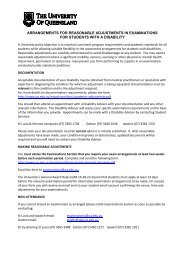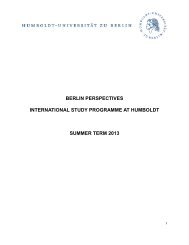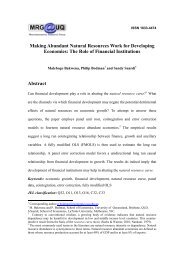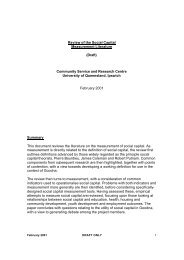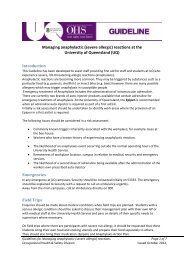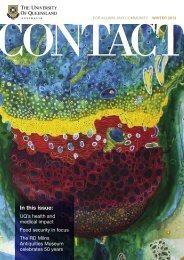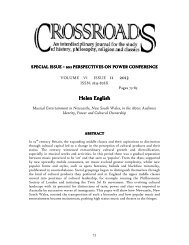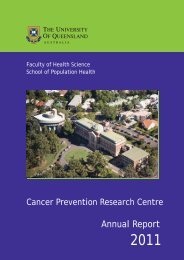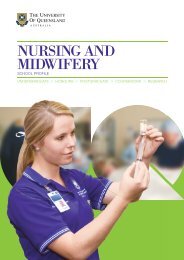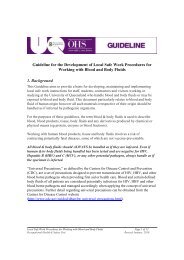Blood and - University of Queensland
Blood and - University of Queensland
Blood and - University of Queensland
You also want an ePaper? Increase the reach of your titles
YUMPU automatically turns print PDFs into web optimized ePapers that Google loves.
Risk Assessment <strong>and</strong> TrainingEach department/school/centre is responsible for ensuring the safety <strong>of</strong> staff, students, contractors <strong>and</strong> visitorsby maintaining an ongoing <strong>and</strong> appropriate risk identification <strong>and</strong> management process, which includes thefollowing:Identifying the tasks in which potentially infectious material is h<strong>and</strong>led;Assessing the associated risks;Applying local safe work instructions <strong>and</strong> procedures which result in theMinimisation <strong>of</strong> the risk involved;Implementing the relevant immunisation requirements;Ensuring personal hygiene is appropriate;Inducting new staff, students <strong>and</strong> contractors as well as visitors to the area to ensure they are familiar<strong>and</strong> compliant with the above;Informing all female employees or pregnant woman <strong>of</strong> the risk to the unborn child <strong>of</strong> occupationalexposure to certain microorganisms such as Toxoplasma gondii, Listeria monocytogenes, Coxiella burnetii,rubella <strong>and</strong> hepatitis B, C <strong>and</strong> E viruses.Risk assessment <strong>and</strong> management should be carried out using the UQ Risk Assessment Database at:http://www.uq.edu.au/ohs/index.html?page=29960The following types <strong>of</strong> incidents must be specifically addressed in safe local work instructions: Introduction <strong>of</strong> blood, blood products, tissue or body fluids through the skin or onto mucosal surfaces (eg.Inside mouth, nose or onto eyes); Reporting <strong>of</strong> any “near miss” incidents onto mucosal surfaces (eg. inside mouth, nose <strong>and</strong> into the eye, orneedle stick injuries); Splashes to exposed skin including the face.ImmunisationThe <strong>University</strong>’s Immunisation Policy <strong>and</strong> Guideline should be read in detail as those h<strong>and</strong>ling human or animalblood, blood products, tissues <strong>and</strong> body fluids or performing exposure prone invasive procedures are at risk <strong>of</strong>contracting infectious diseases, some <strong>of</strong> which are vaccine-preventable.Staff <strong>and</strong> students should refer to their school or centre’s immunisation requirements. The <strong>University</strong> alsorecognises that many <strong>of</strong> its students <strong>and</strong> staff perform duties or placements in Queensl<strong>and</strong> Government facilities<strong>and</strong> these students <strong>and</strong> staff (<strong>and</strong> the <strong>University</strong>) are obliged to observe the immunisation requirements imposedby the state government. In particular Queensl<strong>and</strong> Health requires that all potentially at risk health care staff <strong>and</strong>visitors (including students) be vaccinated against hepatitis B. The <strong>University</strong> <strong>of</strong> Queensl<strong>and</strong> adopts <strong>and</strong> complieswith Queensl<strong>and</strong> Health policy in this area.Baseline Serum SampleIt is not recommended that blood samples be taken routinely from new or current staff <strong>and</strong> students for baselineserum levels. However it may be required as a result <strong>of</strong> the outcome <strong>of</strong> a risk assessment <strong>and</strong> the facilitycontainment level involved. Persons working in Physical Containment 3 (PC3) facilities will require healthmonitoring. This may include initial <strong>and</strong> periodic examinations requiring a medical examination, chest X-ray <strong>and</strong>where relevant, a baseline serum sample. Such blood samples must be taken after obtaining informed consent.The sample must be stored securely <strong>and</strong> appropriately bearing in mind the medical <strong>and</strong> legal implicationsinvolved in the subsequent use <strong>of</strong> such specimens.Local Safe Work Procedures for Working with <strong>Blood</strong> <strong>and</strong> Body Fluids Page 2 <strong>of</strong> 8Occupational Health & Safety Division May 2012 , v3.2
Equipment surfaces exposed to potential contamination should be disinfected daily. If necessary the equipmentmanufacturer’s advice should be sought regarding compatibility <strong>of</strong> disinfectants with surfaces or functions. Allinstruments <strong>and</strong> equipment that require service or repair must be cleaned free <strong>of</strong> blood <strong>and</strong> disinfected beforeleaving the laboratory.Local safe work instructions must take into account:The need for transport <strong>and</strong> repair <strong>of</strong> instruments used in areas in which blood <strong>and</strong> body fluids areh<strong>and</strong>led or stored;The requirement that the Biosafety Adviser or the manufacturer be consulted for advice should anyinstrument need external servicing, particularly if it cannot be decontaminated before being transported.Emergency plans <strong>and</strong> proceduresEmergency plans should be prepared in consultation with the Occupational Health Nurse Adviser, the BiosafetyAdviser <strong>and</strong> OHS Division. This plan should be displayed prominently <strong>and</strong> cover the following:Location <strong>of</strong> emergency equipment;UQ Emergency Procedures;Management <strong>of</strong> accidental swallowing <strong>of</strong> potentially hazardous material, accidental skin puncture or cut<strong>and</strong> breakages/leakages.Working in laboratoriesLaboratory design <strong>and</strong> layoutLocal safe work procedures should take into account the following recommendations for laboratory design <strong>and</strong>layout:Laboratory space <strong>and</strong> placement <strong>of</strong> equipment should not create a crowded working environment norinhibit cleaning;Laboratory surfaces <strong>and</strong> floors should be made <strong>of</strong> impervious material to allow for effective cleaning;Facilities for h<strong>and</strong> washing with elbow or foot operated taps should be provided in each work area;Eyewash stations should be available in each work area;Biohazard containers for the safe disposal <strong>of</strong> contaminated materials <strong>and</strong> sharps should be provided inadequate numbers in appropriate places in each work area;Laboratory doors <strong>and</strong> specimen storage areas should be marked as containing a biohazard;Offices <strong>and</strong> study areas should be separated from laboratory work areas;Restriction <strong>of</strong> laboratory access should be enforced as appropriate.Containment <strong>of</strong> aerosolsLocal safe work procedures should be specific about control <strong>of</strong> aerosols:Define the tasks required to always be undertaken in laminar flow cabinets;Define the tasks to be undertaken in Biological Safety cabinets;As a minimum, Class I or Class II cabinets should be used for any procedures likely to produce aerosols <strong>of</strong>blood, bodily fluids or their products (e.g. sonication, agitation, blending, procedures producing foam,froth, spray <strong>and</strong> aerosols as well as the decanting <strong>of</strong> large volumes <strong>of</strong> fluids in open containers);Define the maintenance <strong>and</strong> testing procedures for Biological Safety <strong>and</strong> all ventilation systems to ensurethat they are operating to specification. Ensure they are tested <strong>and</strong> serviced at intervals <strong>of</strong> not more thanone year;Centrifuge tubes should be sealed closed or sealed rotors should be used for spinning <strong>of</strong> any potentiallycontaminated material. Operators should ensure the rotor has completely stopped turning beforeopening the lid.Local Safe Work Procedures for Working with <strong>Blood</strong> <strong>and</strong> Body Fluids Page 5 <strong>of</strong> 8Occupational Health & Safety Division May 2012 , v3.2
Transport <strong>of</strong> SpecimensThe Transport <strong>of</strong> Dangerous Goods Class 6.2 Infectious substances are regulated by the following, depending onthe mode <strong>of</strong> transport:International Air Transport Association (IATA) Dangerous Goods regulationsAustralia Post Dangerous <strong>and</strong> Prohibited Goods <strong>and</strong> Packaging Post GuideAustralian Code for the Transport <strong>of</strong> Dangerous Goods by Road <strong>and</strong> RailThese regulations require m<strong>and</strong>atory training for:Packaging to IATA st<strong>and</strong>ards (i.e. to send biological material on either domestic or international flights);Packaging <strong>and</strong> transport for l<strong>and</strong> transport <strong>of</strong> biological material. An important issue is the lack <strong>of</strong>insurance cover if such material is transported in a private vehicle.If you are transporting biological material, which is either infectious or diagnostic, please contact the BiosafetyAdviser at the Occupational Health <strong>and</strong> Safety Division for advice.Protective clothingDetailed advice about the best type <strong>of</strong> protective clothing appropriate for use in each circumstance can be soughtfrom OH&S Division. The following are important points, which should, as appropriate, be incorporated, in localsafe work instructions <strong>and</strong> on-site training.GlovesAlways wear when likely to be in contact with the specimen or contaminated surfaces or material.Always wear if there is any open skin lesion or dermatitis as these conditions increase the risk <strong>of</strong> infection.Select disposable gloves, which fit well <strong>and</strong> are easily replaced.Damaged gloves must be replaced immediately.Remove gloves after task completion (eg before h<strong>and</strong>ling telephones, performing <strong>of</strong>fice work <strong>and</strong> leavingthe laboratory).If a telephone is contaminated wipe thoroughly with 70% alcohol.Gloves must be worn when working in a biological safety cabinet in PC2 certified facilities.Gloves must be worn when working in PC3 certified facilities.Face <strong>and</strong> Eye ProtectionGownsFootwearFacial protection such as safety glasses, mask or face shield must be worn if there is a risk <strong>of</strong> splashing orspraying <strong>of</strong> blood or body fluids.Eye protection should be worn when transferring blood or bodily fluids. A full-face shield provides thegreatest degree <strong>of</strong> protection (see Guideline on Eye Protection in Laboratories).Contact lenses will not protect the eyes from exposure <strong>and</strong> may absorb chemicals or biologicals.Wear in laboratories at all times <strong>and</strong> remove whenever leaving the laboratory.Back opening or wrap around gowns are preferable <strong>and</strong> ensure gowns have a closed, completely coveredfront.Gowns should be discarded appropriately when soiled or contaminated.Gowns are assumed to be infectious <strong>and</strong> should be kept separate from other linen.Specify closed shoes as appropriate (eg in laboratories).Exclude high heels as appropriate (eg in the laboratory environment).Local Safe Work Procedures for Working with <strong>Blood</strong> <strong>and</strong> Body Fluids Page 6 <strong>of</strong> 8Occupational Health & Safety Division May 2012 , v3.2
Personal hygieneThe following are important points, which should, as appropriate, be included in local safe work instructions <strong>and</strong>on-site training.H<strong>and</strong> WashingH<strong>and</strong> CareAttention to h<strong>and</strong> washing is an essential part <strong>of</strong> good practice.H<strong>and</strong>s should be washed thoroughly with soap <strong>and</strong> water immediately if contaminated with blood orother body fluids or if gloves have been torn or punctured.All wounds should be covered with waterpro<strong>of</strong> dressings.H<strong>and</strong>s should be washed at completion <strong>of</strong> the workday or session.Elbow or foot operated taps should be available.The use <strong>of</strong> moisturising cream is recommended where frequent h<strong>and</strong> washing is required.Antimicrobial h<strong>and</strong> gels are available with moisturisers <strong>and</strong> these can reduce the drying effects <strong>of</strong>frequent h<strong>and</strong> washing.Nails should be kept trimmed <strong>and</strong> clean.Avoiding contactStaff must avoid inadvertent contact with their skin or mucosal surface (eyes, mouth).Mouth pipetting is prohibited.Cosmetics must not be applied in the laboratory <strong>and</strong> long hair should be tied back.Food <strong>and</strong> drink must not be kept in nor consumed in the laboratory.Skin injuryAll skin problems such as cuts, abrasions, exudations <strong>and</strong> exudative rashes should be covered by awaterpro<strong>of</strong> dressing applied prior to entering the laboratory.Local Safe Work Procedures for Working with <strong>Blood</strong> <strong>and</strong> Body Fluids Page 7 <strong>of</strong> 8Occupational Health & Safety Division May 2012 , v3.2
Useful Links<strong>University</strong> <strong>of</strong> Queensl<strong>and</strong>:Incident Reporting: http://www.risk.admin.uq.edu.au/uq-injury/forms/default_content.aspAlternative Programs for Students with a Disability (Students with a <strong>Blood</strong>- borne Virus):https://ppl.app.uq.edu.au/content/3.50.08-alternative-academic-arrangements-students-disabilityDisability Action Plan: http://www.uq.edu.au/equity/docs/UQ-Disability-Action-Plan-2011-2014.pdfStaff Responsibilities for Occupational Health <strong>and</strong> Safety:https://ppl.app.uq.edu.au/content/2.10.04-staff-responsibilities-occupational-health-<strong>and</strong>-safetyFirst Aid Policy: https://ppl.app.uq.edu.au/content/2.30.10-first-aid#PolicyHepatitis B Information for Students <strong>and</strong> Staff exposed to Human <strong>Blood</strong> <strong>and</strong> <strong>Blood</strong> Products:http://www.uq.edu.au/ohs/pdfs/hepb.pdfImmunisation Policy:https://ppl.app.uq.edu.au/content/2.30.15-immunisation#PolicyRisk Assessment database:https://new.risk.admin.uq.edu.au/Signin.aspxExternal links: <strong>Blood</strong> <strong>and</strong> Body Fluid Exposure; Management <strong>of</strong>:http://www.health.qld.gov.au/CHRISP/IC_GUIDELINES/CONTENTS.ASP Hepatitis B Fact Sheet: http://access.health.qld.gov.au/hid/Infections<strong>and</strong>Parasites/ViralInfections/hepatitisB_fs.asp Hepatitis B information (concerning sexual Health) Queensl<strong>and</strong> Health:http://www.health.qld.gov.au/sexhealth/default.asp Hepatitis C information:http://access.health.qld.gov.au/hid/Infections<strong>and</strong>Parasites/ViralInfections/hepatitisC_fs.asp HIV information:http://access.health.qld.gov.au/hid/Infections<strong>and</strong>Parasites/SexuallyTransmittedDiseases/hivAndAids_fs.asp Infected Health Care Workers-Management <strong>of</strong>:http://www.medicalboard.gov.au/Notifications.aspx (information onthe management <strong>of</strong> impaired practitioners <strong>and</strong> students) Infection Control Guidelines Communicable Diseases Network Australia, the National Public Health Partnership <strong>and</strong>the Australian Health Ministers’ Advisory Council January2004:http://www.health.gov.au/internet/main/publishing.nsf/Content/icg-guidelines-index.htm Safety in Laboratories (Microbiology) St<strong>and</strong>ards Australia <strong>and</strong> New Zeal<strong>and</strong> AS/NZS 2243.3:2010:o http://www.saiglobal.com/online/autologin.asp Queensl<strong>and</strong> Health Infection Control Guidelines, 2008:http://www.health.qld.gov.au/CHRISP/IC_GUIDELINES/CONTENTS.ASP Health care associated infections-Centre for Disease Control: http://www.cdc.gov/hai/*Invasive procedures include any surgical entry into tissue, body cavities or organs, or repair <strong>of</strong> traumatic injury, <strong>and</strong> carry aparticularly high risk <strong>of</strong> infection. “Exposure prone procedures” area subset <strong>of</strong> invasive procedures. These are usuallycharacterised by the potential for direct contact between the skin (usually fingers <strong>and</strong> thumb) <strong>of</strong> the HCW <strong>and</strong> sharp surgicalinstruments, needles, or sharp tissues (spicules <strong>of</strong> bone or teeth) in body cavities or in poorly visualised or confined bodysites, including the mouth. In the broader sense, <strong>and</strong> for the purpose <strong>of</strong> these guidelines, an exposure prone situation isconsidered to be any situation where there is a potentially high risk <strong>of</strong> transmission <strong>of</strong> blood borne disease from HCWs topatients during medical or dental procedures.The policy <strong>and</strong> guidelines have been modified with permission from similar documents published by Monash <strong>University</strong>.Contact for Additional InformationOccupational Health Nurse AdviserFiona CoulthardEmail: f.coulthard@uq.edu.auPhone: 07 3365 4883 (ext 54883)Local Safe Work Procedures for Working with <strong>Blood</strong> <strong>and</strong> Body Fluids Page 8 <strong>of</strong> 8Occupational Health & Safety Division May 2012 , v3.2


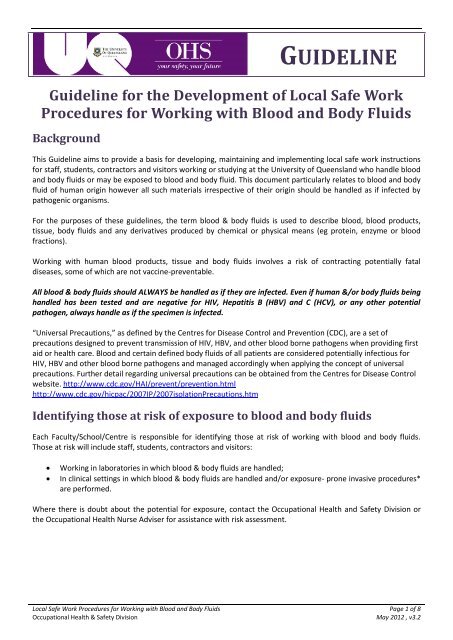

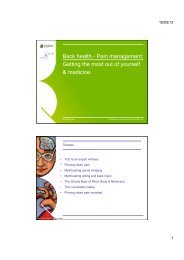
![Recycling [ PDF, 62KB ] - University of Queensland](https://img.yumpu.com/51805185/1/184x260/recycling-pdf-62kb-university-of-queensland.jpg?quality=85)
